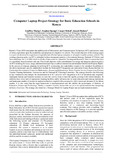| dc.description.abstract | Kenya’s Vision 2030 recognizes the enabling role of Information and Communication Technology (ICT) and anchors some of its key aspirations upon the availability and adoption of computers for schools. The overall objective of this strategy paper is to provide direction for acquisition of equitable and efficient laptop computers to all pupils in public primary schools. The existing education policy on ICT is imbedded in three documents namely; e-Government Strategy, National ICT Policy and Sessional Paper No. 1 of 2005 which is a Policy Framework for Education, Training and Research. There is a need therefore to consolidate these documents into one. The overall objective of the consolidation is to merge and integrate education policy on ICT including the scope, usage, administration and ways to address innovations and attendant Intellectual Property Rights. In the process of strategic planning for utilizing ICT in education, key stakeholders require to be consulted. In addition to the above mentioned, specific stakeholders include the National ICT integration and innovation Centre, Kenya Institute for Curriculum Development, Center for Mathematics, Science and Education in Africa, Teacher Service Commission, Primary Teacher Training Institutions, Universities and the National ICT Steering Committee. The strategy identifies the following as key weaknesses that hamper the implementation of ICT projects: slow integration of ICT in operations and programs; inadequate human and financial resources in some key service areas to meet the rapidly growing work-related demands. In addition there exists lack of appropriate learning facilities and/or infrastructure in some education and training institutions and inadequate number of trainers in modern technology coupled with a mismatch of skills learnt and demands of the labour market. It is also noted that the legal framework is non-harmonized and this inhibits the performance of Ministry of Education, Science and Technology. Further, a number of policy frameworks are yet to be operationalized thus hampering delivery of services. The strategy also identifies a Strategic Model for Laptop Project and an implementation matrix. | en_US |

